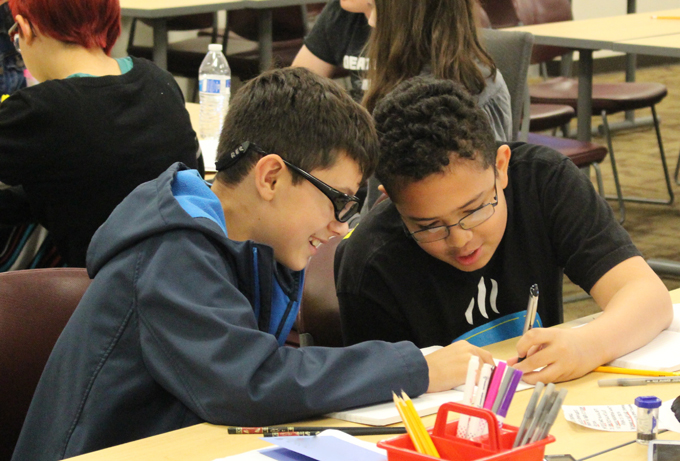
Picture this: a Saturday morning, the room buzzing with conversation and movement. The youth writers sitting at the Comics/Graphic Novels table laugh and nudge each other, pointing out details in their images and words. The university student who has organized this breakout session sits nearby, guiding and encouraging them.
Assorted graphic novels and comics, how-to books, art supplies, and templates are within easy reach. Amid the hum, one writer’s attention is fastened on a How to Draw Superheroes book. He turns some pages quickly and pauses on others. When he is ready to stop reading, he claims a big box of crayons and begins his own Superman and Doctor Octopus story.
At a time when we are seeing cuts to creative writing and arts education in schools, having spaces such as this one where young people can pursue their love of writing and explore different ways to write is crucial.
This has been the philosophy behind our Young Authors’ Studio (YAS) initiative, a free writing workshop at Arizona State University (ASU) for students in grades 5–12. During the seven-week program, these elementary through high school students write and learn alongside ASU students, who guide them through a range of high-interest activities they design.
The structure of Young Authors’ Studio
YAS is held at ASU’s Polytechnic campus. Upper-division ASU students from Wendy Williams’s project-based English course, Mentoring Youth Writers, earn internship credit as they plan, promote, and run the program.
Williams created YAS in fall 2017 to reach students who like to write in forms that are not always taught in school (e.g., spoken word poetry or songwriting). Her student mentors spent five, four-hour sessions designing the program, which then evolved into a seven-week writing series running from October to December for approximately 18 students. The series, held again in 2018 with 31 students, consisted of six themed workshops and a public performance and writing gallery.
The mentors also hosted an information session for families. The YAS writing workshops took place from 9:30 a.m. to 11:30 a.m. on Saturdays, and mentors were on campus from 9 a.m. to 1 p.m. to plan, run YAS, and debrief.
Mentors typically began each workshop by inviting everyone to write in their journals. Afterward, the youth writers attended their choice of two small-group breakout sessions (each mentor offered a different breakout each day). Then the writers met in teams, small communities where they shared and reflected on their writing each week with an assigned mentor.
This program aims to show young people how fun and varied writing can be. For example, themed workshops have included narrative writing, music and poetry, art and writing, drama, genres, and revision and rehearsal. Small-group breakout sessions have explored novel outlining, songwriting, comics, tableaux, character creation, and many other topics. Breakout sessions encourage youth writers to focus on writing elements and experiment with different types of writing.
Celebrating youth writing
The program culminated in a public performance and writing gallery for families and friends. Mentors helped set up the gallery with the writers’ name cards and samples of their work. Sticky notes and pens were available so guests, youth writers, and mentors could leave comments. Then everyone headed into the performance space, where the writers shared pieces they composed.
This showcase highlighted one of the primary missions of YAS: celebrating youth voices.
Just as it benefits the student writers, it also benefits the student mentors. Our mentors cultivated a range of real-world skills. They problem-solved with each other, developed and led writing activities, worked with youth, and communicated with parents. Mentors designed marketing materials, promoted the program, and ran the YAS email account and social media. The 2017 cohort also presented their curriculum to English teachers at a local conference.
Inspiring the next generation
Adding another layer of purpose to the initiative, YAS is set up as a writing lab that allows researchers to learn more about mentoring and youth authorship. ASU graduate students are encouraged to study an aspect of the program and write for publication. As a bonus to us, study findings will help shape future iterations of our program.
Moving forward, we expect to watch our YAS initiative continue to grow, and we look forward to bringing more creative writing opportunities to our area students to help shape the next generation of authors and creative thinkers.
Wendy R. Williams, an ILA member since 2011, is an assistant professor at Arizona State University and the director of Young Authors’ Studio. She recently published Listen to the Poet: Writing, Performance, and Community in Youth Spoken Word Poetry (University of Massachusetts Press).
Stephanie F. Reid, an ILA member since 2016, is a doctoral student in the Learning, Literacies, and Technologies program at Arizona State University.
This article originally appeared in the January/February 2019 issue of Literacy Today, ILA’s member magazine.